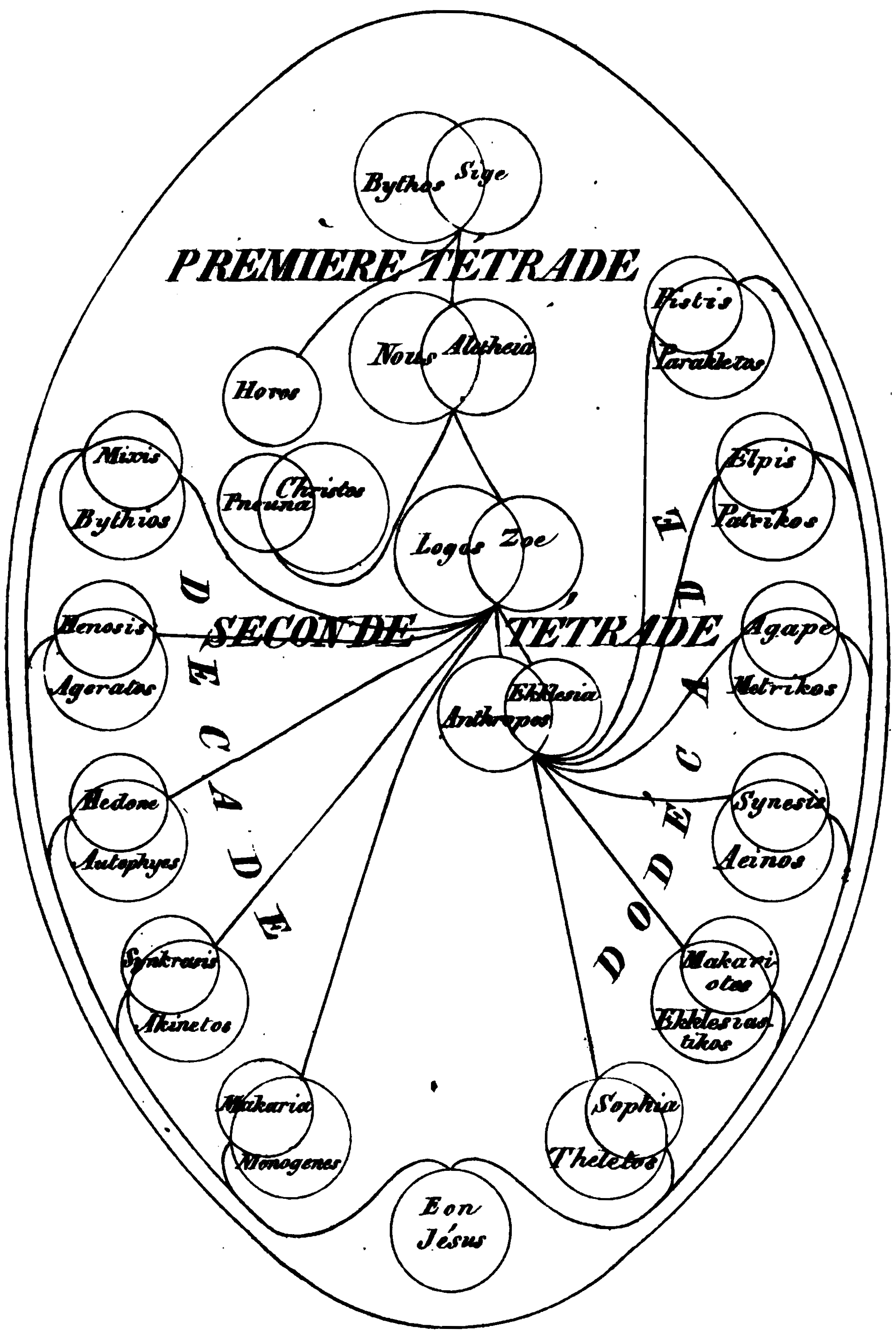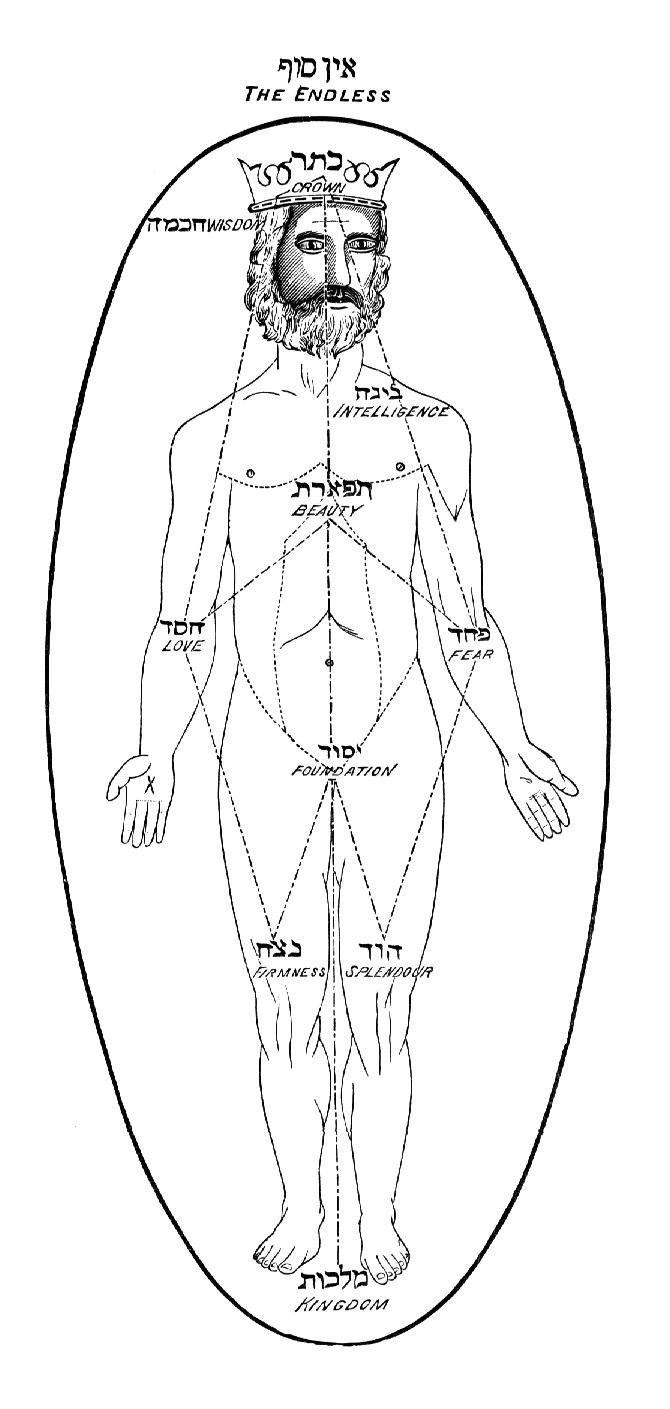|
Aeon (Gnosticism)
In many Gnostic systems, various emanations of God are known by such names as One, Monad, ''Aion teleos'' (αἰών τέλεος "The Broadest Aeon"), Bythos (, "depth" or "profundity"), ''Proarkhe'' ("before the beginning", ), ''Arkhe'' ("the beginning", ), and Aeons. In different systems these emanations are differently named, classified, and described, but emanation theory is common to all forms of Gnosticism. In Basilidian Gnosis they are called sonships (υἱότητες ''huiotetes''; sing.: υἱότης ''huiotes''); according to Marcus, they are numbers and sounds; in Valentinianism they form male/female pairs called syzygies (Greek , from σύζυγοι ''syzygoi'', lit. "yokings together"). This source of all being is an Aeon, in which an inner being dwells, known as ''Ennoea'' ("thought, intent", Greek ), ''Charis'' ("grace", Greek ), or ''Sige'' ("silence", Greek ). The split perfect being conceives the second Aeon, ''Nous'' ("mind", Greek Νους), within its ... [...More Info...] [...Related Items...] OR: [Wikipedia] [Google] [Baidu] |
Gnosticism
Gnosticism (from grc, γνωστικός, gnōstikós, , 'having knowledge') is a collection of religious ideas and systems which coalesced in the late 1st century AD among Jewish Jews ( he, יְהוּדִים, , ) or Jewish people are an ethnoreligious group and nation originating from the Israelites Israelite origins and kingdom: "The first act in the long drama of Jewish history is the age of the Israelites""The ... and early Christian sects. These various groups emphasized personal spiritual knowledge (''gnosis'') above the orthodox teachings, traditions, and authority of religious institutions. Gnostic cosmogony generally presents a distinction between a supreme, hidden God and a malevolent demiurge, lesser divinity (sometimes associated with the Yahweh of the Old Testament) who is responsible for creating the nature, material universe. Consequently, Gnostics considered material existence flawed or evil, and held the principal element of salvation to be direct ... [...More Info...] [...Related Items...] OR: [Wikipedia] [Google] [Baidu] |
Valentinus (Gnostic)
Valentinus (also spelled Valentinius; – ) was the best known and, for a time, most successful early Christian Gnostic theologian. He founded his school in Rome. According to Tertullian, Valentinus was a candidate for bishop but started his own group when another was chosen. Valentinus produced a variety of writings, but only fragments survive, largely those quoted in rebuttal arguments in the works of his opponents, not enough to reconstruct his system except in broad outline. His doctrine is known only in the developed and modified form given to it by his disciples, the Valentinians. He taught that there were three kinds of people, the spiritual, psychical, and material; and that only those of a spiritual nature received the ''gnosis'' (knowledge) that allowed them to return to the divine Pleroma, while those of a psychic nature (ordinary Christians) would attain a lesser or uncertain form of salvation, and that those of a material nature were doomed to perish. Valentinu ... [...More Info...] [...Related Items...] OR: [Wikipedia] [Google] [Baidu] |
Ancient Egyptian Deities
Ancient Egyptian deities are the God (male deity), gods and goddesses worshipped in ancient Egypt. The beliefs and rituals surrounding these gods formed the core of ancient Egyptian religion, which emerged sometime in prehistoric Egypt, prehistory. Deities represented natural phenomenon, natural forces and phenomena, and the Egyptians supported and appeased them through sacrifice, offerings and rituals so that these forces would continue to function according to ''maat'', or divine order. After the founding of the Egyptian state around 3100 BC, the authority to perform these tasks was controlled by the pharaoh, who claimed to be the gods' representative and managed the Egyptian temple, temples where the rituals were carried out. The gods' complex characteristics were expressed in Egyptian mythology, myths and in intricate relationships between deities: family ties, loose groups and hierarchies, and combinations of separate gods into one. Deities' diverse appearances in art ... [...More Info...] [...Related Items...] OR: [Wikipedia] [Google] [Baidu] |
Adam Kadmon
In Kabbalah, Adam Kadmon (, ''ʾāḏām qaḏmōn'', "Primordial Man") also called Adam Elyon (, ''ʾāḏām ʿelyōn'', "Most High Man"), or Adam Ila'ah (, ''ʾāḏām ʿīllāʾā'' "Supreme Man"), sometimes abbreviated as A"K (, ''ʾA.Q.''), is the first of Four Worlds that came into being after the contraction of God's infinite light. ''Adam Kadmon'' is not the same as the physical ''Adam Ha-Rishon''. In Lurianic Kabbalah, the description of ''Adam Kadmon'' is anthropomorphic. Nonetheless, ''Adam Kadmon'' is divine light without vessels, i.e., pure potential. In the human psyche, ''Adam Kadmon'' corresponds to the yechidah, the collective essence of the soul. In Judaism Philo The first to use the expression "original man," or "heavenly man," was Philo, in whose view the , or , "as being born in the image of God, has no participation in any corruptible or earthlike essence; whereas the earthly man is made of loose material, called a lump of clay." The heavenly man, ... [...More Info...] [...Related Items...] OR: [Wikipedia] [Google] [Baidu] |
Colarbasus
In Christian Gnostic religious history, the Colarbasians (from Gk. Colarbasus, Hippol., Ps. Tert.; Colorbasus, Iren., Epiph., Theodoret, Philast. cod., Aug.; ''C. Bassus'' Philast. codd.) were a supposed sect of the 2nd century, deemed heretics, so called from their leader Colarbasus, a disciple of Valentinius. Colarbasus, along with Marcus, another disciple of Valentinius, was said to maintain the whole plenitude, and perfection of truth and religion, to be contained in the Greek alphabet; and that it was for this reason that Jesus was called the ''Alpha and Omega''. Analysis The name occurs first, and that only incidentally, in a solitary passage of Irenaeusi. 14, 1 which has been the subject of much discussion. Marcus, Irenaeus seems to say, boasted that he alone was allowed to become the womb and receptacle of the Sigé (''Silence'') of Colarbasus; the offspring to which he gave birth being the statement and revelation recorded afterwards. There is no previous mention of Col ... [...More Info...] [...Related Items...] OR: [Wikipedia] [Google] [Baidu] |
The Detection And Overthrow Of Falsely So-Called Gnosis
''Against Heresies'' (Ancient Greek: Ἔλεγχος καὶ ἀνατροπὴ τῆς ψευδωνύμου γνώσεως, ''Elenchos kai anatropē tēs pseudōnymou gnōseōs'', "On the Detection and Overthrow of the So-Called Gnosis"), sometimes referred to by its Latin title ''Adversus Haereses'', is a work of Christian theology written in Greek about the year 180 by Irenaeus, the bishop of Lugdunum (now Lyon in France). In it, Irenaeus identifies and describes several schools of Gnosticism, as well as other schools of Christian thought, and contrasts their beliefs with orthodox Christianity. Until the discovery of the Library of Nag Hammadi in 1945, ''Against Heresies'' was the best surviving contemporary description of Gnosticism. Today, the treatise remains historically important as one of the first unambiguous attestations of the canonical gospel texts and some of the Pauline epistles. Irenaeus cites from most of the New Testament canon, as well as the noncanonical ... [...More Info...] [...Related Items...] OR: [Wikipedia] [Google] [Baidu] |
Irenaeus
Irenaeus (; grc-gre, Εἰρηναῖος ''Eirēnaios''; c. 130 – c. 202 AD) was a Greek bishop noted for his role in guiding and expanding Christian communities in the southern regions of present-day France and, more widely, for the development of Christian theology by combating heterodox or Gnostic interpretations of Scripture as heresy and defining the Catholic and Orthodox doctrines of the Apostolic Churches. Originating from Smyrna, he had seen and heard the preaching of Polycarp, who in turn was said to have heard John the Evangelist, and thus was the last-known living connection with the Apostles. Chosen as bishop of Lugdunum, now Lyon, his best-known work is '' Against Heresies'', often cited as ''Adversus Haereses'', a refutation of gnosticism, in particular that of Valentinus. To counter the doctrines of the gnostic sects claiming secret wisdom, he offered three pillars of orthodoxy: the scriptures, the tradition handed down from the apostles, and the tea ... [...More Info...] [...Related Items...] OR: [Wikipedia] [Google] [Baidu] |





